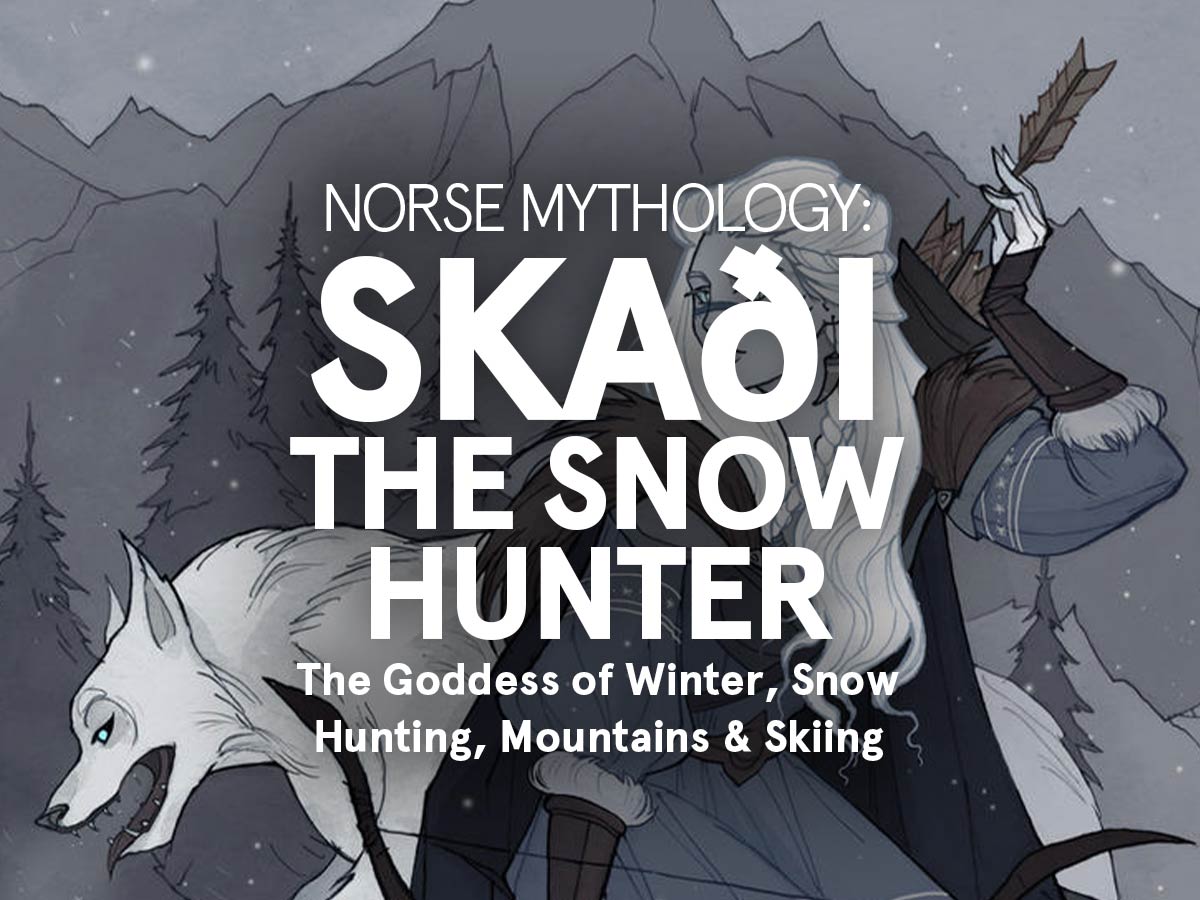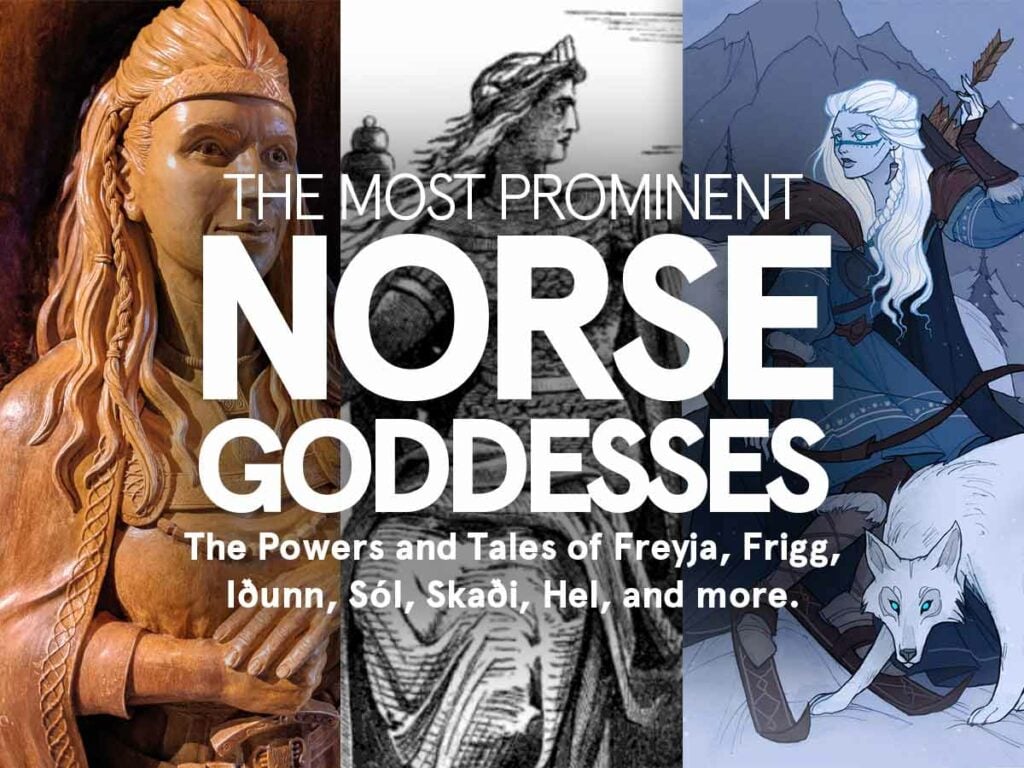For the Old Norse, every cold and harsh winter was brought on by Skaði, the beautiful but dangerous Jötunn (giant) who lives up in the mountains in a hall called Thrymheim — the thunder home. Skaði was associated with winter, skiing, mountains, and bowhunting, and was as determined and unforgiving, as she was charming and skilful.
Odin described her as “the shining bride of the gods”, and chose her as his wife after she had split up with her first husband Njörðr. And to top it all off, she is credited with poisoning the ever-scheming bad guy of Norse mythology; Loki.
Let’s dive deeper into the mysterious and powerful saga of Skaði; the giant skiing mountain-huntress who brings about winter.
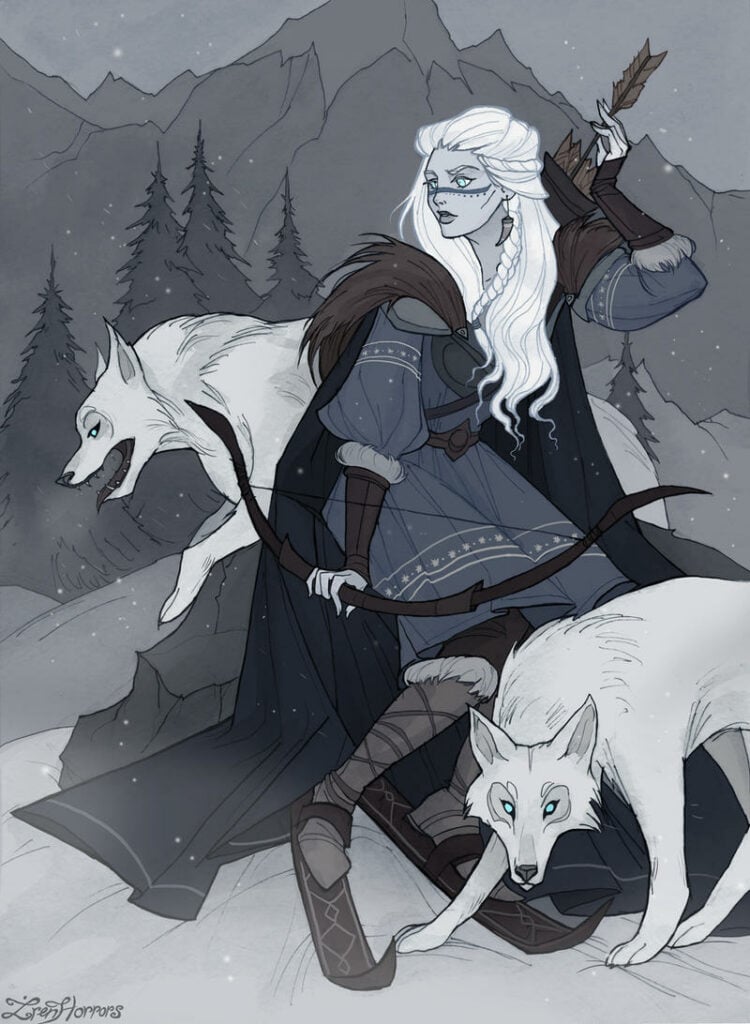
All of the information in this article is based on the oldest Norse mythology sources we have access to, the Poetic Edda, the Prose Edda, and the Heimskringla. I also include various examples of beautiful art, including both older (19th-20th century) and newer (21st century) examples.
- How Skaði is Described in the Traditional Norse Sources
- What Kind of God is Skaði?
- What Are Skaði's Powers?
- Skaði's Home: Þrymheimr / Thrymheim
- Skaði and Njördr: an ill-fated marriage
- Skaði & Odin: a More Harmonious Partnership
- Skaði: the Likely Mother of Freyr & Freya
- Skaði: the Poisoner of Loki
- What Does the Name Skaði Mean?
- Skaði's Legacy: Origins of the Name Scandinavia?
- Skaði in Modern Times & Pop Culture
How Skaði is Described in the Traditional Norse Sources
Skaði is a Norse Jötunn (giant) associated with winter, snow, hunting, skiing, and mountains according to the sagas. She is described as strong-willed, beautiful, vengeful, and ruthless; having both charmed and poisoned other gods. According to Old Norse belief, she brought about winter each year.
Let’s look at how the traditional Norse sources (the Eddas and Heimskringla) describe her more specifically.
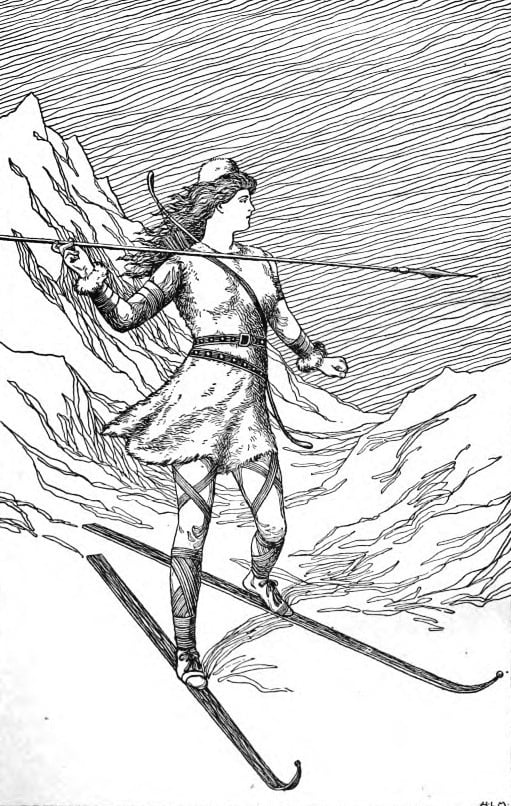
Skaði in the Poetic Edda
In the Poetic Edda, Skaði is described as the daughter of the Jötunn (Giant) Þjazi (Tjatse) and possibly the mother of Freyr and Freya.
In the poem Lokasenna (“Loki’s quarrel”), Skaði gets into a heated exchange with Loki who bragged that he was first in slaying her father Tjatse, and she starts it off by accusing Loki of being light-hearted:
"You're light-hearted, Loki! Long shalt thou not so run loose and free; For on the angular rock With the guts of a cold boy ...the gods of wrath shall bind thee."
To which Loki said:
"If on an angular rock with the bowels of a cold boy the gods of wrath bind me, the first and last shall know in the feud I was, when Tjatse lost his life."
With the following response from Skadi:
"If the first and last in the feud you were, when Tjatse lost his life, then know, from my sanctuary and holy field For thee shall cold counsel come."
And a final retort from Loki:
"Easier in the case against Lauvey's son thou wert, when thou didst invite me to thy bed; which we might mention, if we shall carefully enumerate all our faults."
After some more quarrelling and insults exchanged between Loki and most of the other gods, he is eventually jailed by the assembly of gods before him.
Skaði then takes a snake and ties it so that the venom drips down in Loki’s face.
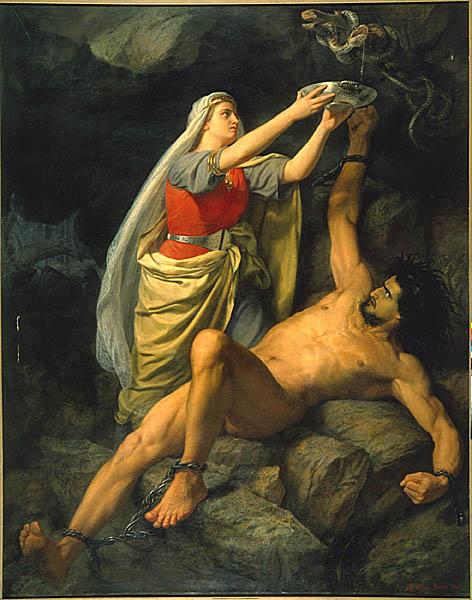
Loki’s wife Sigyn stands beside him, and manages to catch the drops of venom with a bowl before they touch him.
The bowl fills eventually though, and when she empties it out the venom drips onto and burns Loki’s face horribly, resulting in a furious convulsion from Loki — which is said to be the cause of every earthquake since.
Skaði in the Prose Edda
After the death of her father Tjatse, the Prose Edda tells of Skadi taking her helmet, her hauberk (chain mail armor), and “all weapons of war” — and traveled to Asgard to demand revenge.
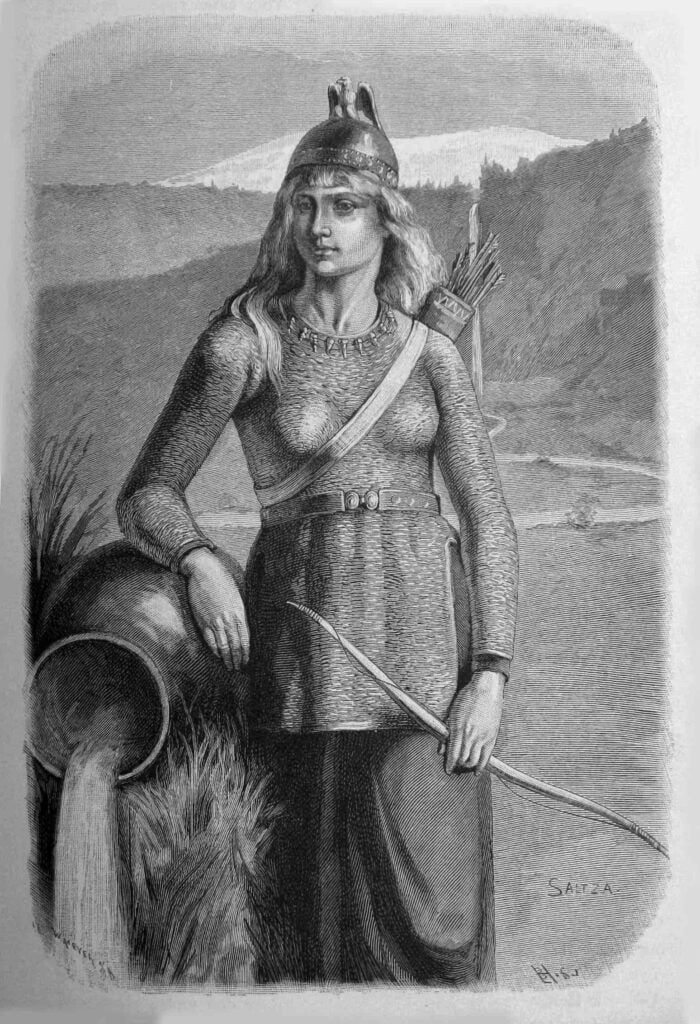
Artwork by Carl Fredrik von Saltza
The Aesir felt that Skaði deserved a settlement, and she demands an advantageous marriage to one of the Aesir (gods), and that they do something she thinks impossible: to make her laugh.
She got to choose her future husband by only judging each Aesir’s feet, and picked a pair of beautiful feet she thought belonged to Odin‘s son Balder (who was described as very handsome and was her intended pick).
The beautiful feet, however, belonged to the god of the wind, sea, seafaring, and fishing; Njördr. It seems Skaði never quite got past this disappointment, as their marriage was described as far from happy.
The Aesir also made her laugh in the end, by having Loki tie a chord around the beard of a goat and around his own testicles, and then pull back and forth — both squealing in agony (which Skaði seemed to have found funny).
Skaði in the Heimskringla
In the Heimskringla‘s Ynglinga Saga, we learn that Skaði eventually leaves Njördr due to their differences, only to marry Odin and have many sons together:
Njord was given a woman called Skaði as a wife. She would not live with him, but married Odin instead. They had many sons.
Heimskringla’s Ynglinga Saga
What Kind of God is Skaði?
In the Prose Edda, we learn that Skaði is connected to winter, skiing, hunting, and mountains, and she is described as “the wise god-bride”, and “the shining bride of the gods” in the Poetic Edda.
In both versions, we learn of her vengeful and wilful ways; raging against the Aesirs when her father is killed and refusing to budge to Njördr‘s demands to stay in his oceanside hall (instead of her mountain hall) when they marry.
What Are Skaði’s Powers?
Skaði is a Jötunn (giant) believed to have a connection with and power over winter and mountains, as well as an extremely skilled archer and huntress. Her bow and arrows are said to be able to kill anything they hit. As a goddess associated with winter, she is also an expert skier and has been known to race down mountains at high speeds.

In addition to her physical prowess, Skaði is also said to have magical powers, such as controlling the weather and creating snowstorms and blizzards at will.
Skaði’s Home: Þrymheimr / Thrymheim
After the death of her father Tjatse, Skadi inherits Þrymheimr (Thrymheim), which is translated as “thunder home”, “crash home”, or “power house” depending on the source and spelling.
Either way, it is a fitting name for the home of a Jötunn (giant) who is the goddess of mountains (among other things).

Here is how Þrymheimr is described in Grímnismál:
Thrymheim the sixth is named, where Þjazi dwelt that all-powerful Jötun; but Skaði now inhabits, the bright bride of the gods, her father's ancient home.
Skaði and Njördr: an ill-fated marriage
Skadi and Njördr are one of the most well-known Norse myths, largely due to the classic Scandinavian folktale Heimskringla (as told by Snorre Strulasson). In this story, Skadi is married to the god of wind and water Njördr, and their relationship is extremely stormy (hah!), to say the least.
After they married, Skadi wanted to live in the mountain hall of her father, Thrymheim, while Njörd wanted to live in his ocean home, Noatun.
So they decided to live nine nights (or winters, depending on the source) in Thrymheim, and three in Nóatún.
The way they divide their residency (9 vs 3 days/winters instead of an even split between the two) hints of Skadi’s determination and unwillingness to compromise.
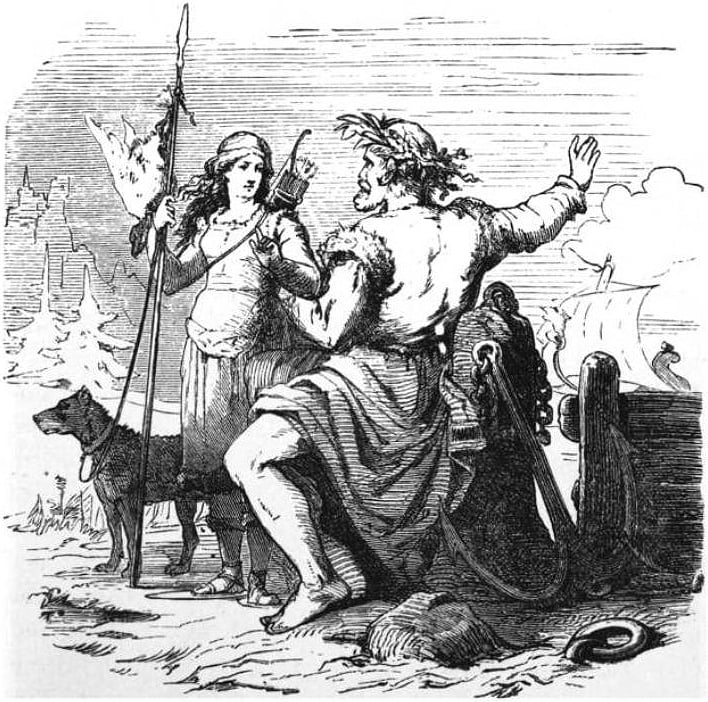
Njörd isn’t happy with the mountains though, saying the following after coming down the mountain:
I was sad in the mountains, Though I was not there long: Only nine nights. The wolf howls Seemed to me sad Compared to the swans' song.
Skadi in return, did not have much better things to say about the ocean hall Nóatún:
Sleep I could not On the seashore To the cries of the birds. The seagull, That comes from the sea; Wakes me every morning.
Skadi’s icy demeanor was no better than Njördr’s longing for the open seas, and eventually their relationship proves too difficult, resulting in the two leaving each other.
Skaði & Odin: a More Harmonious Partnership
Unlike her tumultuous relationship with Njördr, Skaði and Odin supposedly had a much more harmonious partnership. This is mainly derived from the fact that they were described to have “many sons” together.
Perhaps it was Odin’s act of throwing the eyes of her dead father’s Tjatse up in the sky — thought to have created the sun and moon — that sealed the deal?
Skaði: the Likely Mother of Freyr & Freya
Right after we find out that Skaði and Njördr separate, we are told that Njördr has two children: Freyr and Freya.
Although we are not told specifically who their mother is, scholars and artists alike assume they are a result from their marriage, mostly as we are not told of any second wife of Njördr’s.
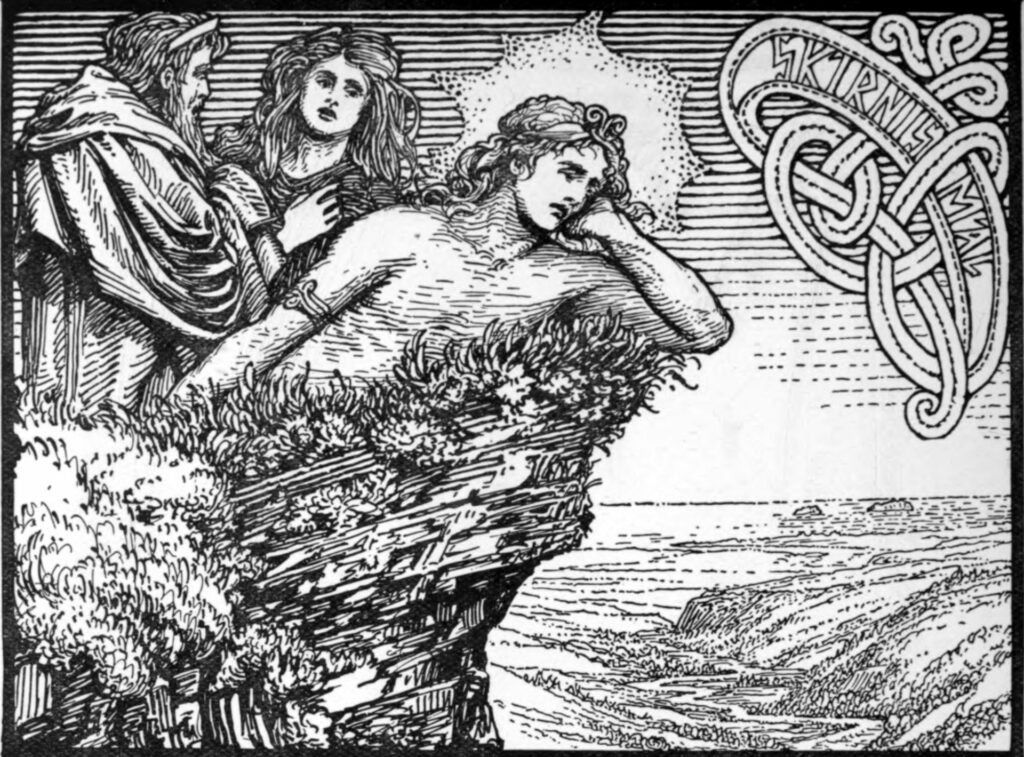
Freyr and Freya are both described as “fair in appearance and mighty”, and the following is written about them in the chapter 24 of the Heimskringla:
Frey is the most excellent of the Asarne. He rules over rain and sunshine, and the crops of the earth, and should be called upon for good crops and peace. He also rules over men’s property. Freya is the most glorious of the Asynyas; she possesses the dwelling place in heaven called Folkvang, and when she rides into battle, one half belongs to her and the other to Odin.
Skaði: the Poisoner of Loki
After Loki is accused of slaying Skaði’s father Tjatse, the Aesir ties him down with his son’s Nare’s intestines, while Skaði ties a venomous snake above the head of Loki, so that the venom drips down toward Loki’s face.
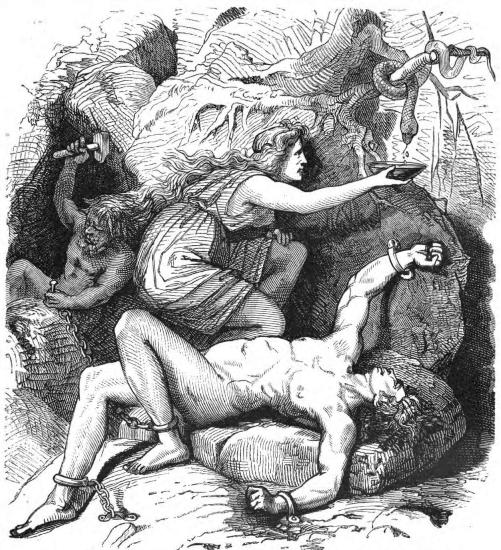
As the venom eventually drips onto and burns Loki’s face horribly, this results in a furious Loki — causing not just one, but also every earthquake since.
What Does the Name Skaði Mean?
Skaði can be written as Skadi and Skathi (English), or Skade (Swedish), and most likely means “shadow”, or “the shadowy one”. It would then be connected to the Gothic skadus, Old English sceadu, Old Saxon scado, and Old High German scato.
Other theories include that it could simply be connected to the Old Norse word skaði, which means “harm”, “injury”, or “damage. It would then be connected to the Swedish skada, as well as the English scathe.
Skaði is also sometimes called Ǫndurdís or Skiddis, which means “the Skier”.
Skaði’s Legacy: Origins of the Name Scandinavia?
The name “Scandinavia” is theorized by some historians to be derived from Skaði’s name, and is then thought to mean “the Island of Skaði”. This is, however, just a theory, with many other explanations seeming more probable.
Find out more about the etymology of the name Scandinavia in the article below:
Skaði in Modern Times & Pop Culture
Like with most of the Norse mythology figures, there have been tons of modern interpretations of Skaði in recent times.
Let’s take a look at some tattoo designs, modern art interpretations, and finally some interesting cosplay costumes!
Skaði Tattoos
Modern Art Interpretations Featuring Skaði
Skaði Cosplay
Sources:
https://heimskringla.no/wiki/Snorre_Sturlesons_Edda_samt_Skalda_Gylfaginning
http://runeberg.org/eddan/se-08.html
https://historiska.se/norse-mythology/skadi-en/
 The Norse ‘Valknut’: Origins & Meanings of the Triangle Knot
The Norse ‘Valknut’: Origins & Meanings of the Triangle Knot Fenrir: The Giant Wolf Who Slayed Odin in Norse Mythology
Fenrir: The Giant Wolf Who Slayed Odin in Norse Mythology 21 Norse Goddesses and Their Influence, Powers & Myths
21 Norse Goddesses and Their Influence, Powers & Myths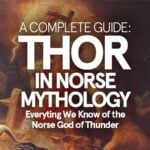 Thor in Norse Mythology: A Historical Guide to the God of Thunder
Thor in Norse Mythology: A Historical Guide to the God of Thunder

